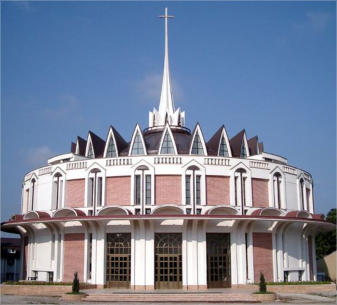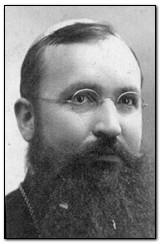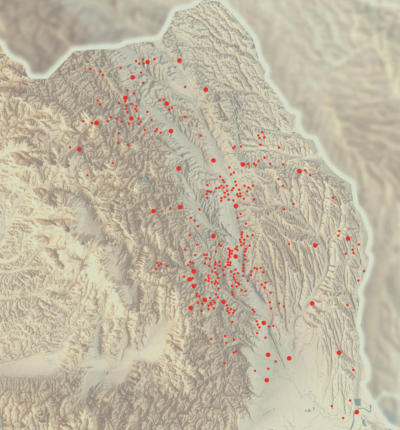
The religion of the so-called "csangos"
Settled in Moldavia, the so-called “csangos”
kept the Roman Catholic religion which they
had in Transylvania, to their new homes being
pastored - at first - by Italian priests, Germans or
Poles priests and in some short periods by Hungarian priests.
Today's
territory
of
Romania
was
-
like
other
European
territories
-
a
missionary
field
where
the
apostles
transmitted
the
Christian
teaching,
since
the
first
century
of
Christianity.
Christian
communities
developed
on
this
territory,
especially
on
the
Black
Sea
coast
and
on
the
banks
of
the
Danube.
The
influence
of
the
Roman
Christians
among
the
settlers
brought
after
the
conquest
of
Dacia
also
played
an
important
role
in
Christianization,
reason
for
which
the
church
organization
of
that
period
is
closely
related
to
the
Roman
administrative-territorial
systematization,
the
Christian
communities
existing
on
the
territory
of
Dacia
being
under
the
Pope's
jurisdiction.
Rome),
through
its
vicar
of
Thessalonica.
After
the
Great
Schism
(1054),
Roman
Catholic
communities
continued
to
exist,
being
supported
by
the
missionary
activity
of
the
Dominican
and
Franciscan
orders,
which
will
lead
to
the
consolidation
and
development
of
these
Catholic
Christian
communities
obeying
the
Pope
(Bishop
of
Rome),
their
existence
being
attested
in
short-term
dioceses
south
of
the
Carpathians,
in
Wallachia
(Severin,
Argeş)
and east of the Carpathians, in Moldova (Milcov, Siret, Baia, Bacau).
The
Milcov
Diocese
(Milcovia
Episcopate)
was
the
first
known
Catholic
diocese
in
Moldova,
being
located
-
most
likely
-
in
today's
area
of
Odobești
or
Focșani
and
which
had
in
pastoral
regions
of
Transylvania, Milcov area (Vrancea), area Siret and Cetatea Albă (on the Dniester, today in Ukraine).
In
1227,
the
Cuman
king,
his
suite
and
15,000
men
were
baptized
in
the
Milcov
river
by
the
Archbishop
of
Strigonius
together
with
the
bishops
Bartholomew
of
Pecs,
Wilhelm
of
Veszprem
and
Raynald of Alba-Iulia.
The
first
ruler
of
the
Milcovia
Episcopate
was
appointed
by
the
pope,
in
1227
Bishop
Theodoric
who
pastored
the
community
from
1227
to
1241
when
both
the
settlement
and
the
diocese
were
destroyed
by
the Mongols, who burned the cathedral, and the bishop was killed, together with 90 monks.
Then
13
other
bishops
took
over
the
leadership
of
the
Milcovia
Diocese:
“Th.
cumanorum
humilis
minister”
?
-
1283;
Leo
?
-
1327;
Vitus
de
Monteferro,
chaplain
to
King
Carol
Robert
?
-
1332;
Thomas
Nympti,
Augustinian
monk
1347-1348;
Bernard
of
Mazovia,
Polish
Dominican
monk
1353-1357;
Albert
de
Usk,
Dominican
monk
?
-
1364;
Nicolae
de
Buda,
Augustinian
monk
1371-1375;
Gobelinus,
bishop
of
Alba-Iulia
?
-
1386;
Laurentiu
?
-
1396;
Emerich
Zechel
-
1431;
Grigore
Jaurini,
vicar
general
at
Strigoniu
1433-1462;
Mihai
Turon,
auxiliary
bishop
of
Strigoniu
1468-1493;
Paul
Ilsine,
parish
priest
of
Strigoniu 1501-1504; Ladislaus of Ondola ? - 1510; Dumitru - 1511; Mihai 1512-1521.
In
1371
the
Diocese
of
Siret
was
established
(1371-1434),
and
in
1418
the
Diocese
of
Baia
was
established
(1418-1523),
which
played
an
important
role
in
organizing
Catholic
life
in
Moldavia.
Seven
bishops succeeded him to the leadership of this diocese, the last being Mikhail Marinoski (1510-1523).
In
1391,
in
addition
to
the
Diocese
of
Siret,
Pope
Boniface
IX
(1389-1404)
founded
the
Diocese
of
Bacau,
due
to
"
the
large
number
of
Catholics
in
Moldavia
and
their
spread
on
the
territory
."
After
the
accession
of
Stephen
the
Great
(1457-1504)
to
the
throne
of
Moldavia
(1457-1504),
the
political
orientation
changed,
having
influences
on
the
organization
of
the
Catholic
minority
in
Moldova.
Poland
could
no
longer
effectively
support
a
bishop
in
Moldova,
and
therefore
the
diocese
is
integrated into Hungary.
From
1818
the
activity
of
the
Catholic
missionaries
from
Moldavia
was
coordinated
from
Iaşi,
the
headquarters
of
the
Apostolic
Vicariate
of
Moldavia,
at
the
helm
of
which
14
apostolic
visitors
succeeded
one another, the last being Nicolae Iosif Camilli, appointed on September 16, 1881.
On
June
27,
1884,
through
the
papal
bull
"Quae
in
christiani
nominis
incrementum",
Pope
Leo
XIII
(1878-1903)
decided
to
end
the
Apostolic
Vicariate
of
Moldavia,
which
had
existed
since
1818,
and
decreed
the
establishment
of
the
Catholic
Episcopate
of
Iasi.
Nicolae
Iosif
Camilli,
a
former
apostolic
visitor
between
1881-1884,
was
appointed
bishop.
Later
the
episcopate
was
led
by
Dominic
Jaquet,
Alexandru
Theodor
Cisar,
Mihai
Robu
and
Anton
Durcovici
who
were
residential
bishops,
otherwise,
at
the head of the diocese, there were apostolic administrators and "ordinary substitutes".
The first bishop from Moldova was Mihai Robu, from Săbăoani, Neamț County.
Currently,
Moldovan
Catholics
are
organized
in
10
deaneries
and
158
parishes,
living
peacefully
with other residents of any religion.
Catholic missionaries about the so-called "csangos" from Moldova
Excerpt
from
the
book
“The
origin
of
the
csangos
from
Moldova”
-
author,
professor
Dumitru
Mărtinaș
•
As
early
as
1234,
a
papal
letter
mentions
that
on
the
territory
of
the
diocese
of
Milcov,
Catholics
mingled with the Wallachians, converted to their faith, becoming a people with them.
•
The
same
mention,
regarding
the
transition
of
Catholics
to
the
Orthodox
religion,
is
made
by
Archbishop
Marco
Bandini
in
the
report
prepared
by
him
in
Bacău,
on
March
2,
1648,
a
document
in
which
were
noted
the
findings
made
during
the
visit
of
the
high
prelate
to
Catholic
localities
in
Moldova.
•
In
1763,
the
Bishop
of
Bacău,
Stanislau
Jezierski
noted
that
“
…
in
all
Moldova
the
number
of
Catholics
increases
only
through
Catholics
coming
from
Transylvania…
”
and
because
these
“
…
Transylvanian
Catholics
belong
to
the
Hungarian
rule…
Moldovans
do
not
call
them Catholics but Hungarians…
”.
•
Also
in
1763,
Iosif
Cambioli,
Prefect
of
the
Franciscan
Mission
in
Moldova,
recorded
“
…
for
seven
years
now,
the
number
of
our
Catholics
has
increased
and
increases
every
day,
not
because
non-Catholics
would
come
to
us,
but
because
in
Hungary
even
more
elected
in
Transylvania
was
and
is
starving
and
now,
since
the
peace
between
the
Austrians
and
the
Prussians
ended,
they
catch
soldiers
by
force
and
that
is
why
whole
families
and
a
large
number
of
young
people
from
14
years
onwards
have
come
and
come
in
this
province, because from this age he enlisted in the army…
”.
According
to
Catholic
missionaries,
in
addition
to
the
heavy
economic
burdens
(huge
taxes
and
fees
paid
by
Transylvanian
Romanians),
which
led
Romanian
peasants
to
take
refuge
in
Moldova,
was
forced
military
service,
introduced
by
the
Austrian
authorities
aimed
at
annexing
Transylvania
and
Bucovina,
with the aim of increasing the army.
•
In
order
to
expand
their
influence
on
Moldovan
Roman
Catholics,
Hungarian
missionaries
tried
to
influence
the
decisions
taken
at
the
Vatican,
suggestive
in
this
regard
being
the
letter
addressed
to
Pope
Pius
VI
by
the
Bishop
of
Alba
Iulia
Ignatius
Batthyani
who
expressed
sorrow
for
the
fate
of
Catholic
believers
in
Moldova,
stating
that
they
understand
only
the
Hungarian
language,
that
Italian
missionaries
do
not
preach,
confess
or
catechize
in
the
language
of
the
people,
Bishop
Ignatius
Batthyani
calling
for
the
withdrawal
of
Italian
missionaries
and
their
replacement
by
Hungarian
missionaries.
Knowing
the
realities
of
Moldavia,
on
January
7,
1788,
Pope
Pius
VI
responded
to
Bishop
Ignatius
Batthyani,
telling
him
that
it
was
not
necessary
to
be
sad
because
Italian
missionaries
use
Romanian
in
pastoral
care,
which
is
the
native
language
of
the
vast
majority
of
the
population.
Catholics
from
Moldova
and
for
the
Hungarian-speaking
believers,
the
Cardinal
of
Esztergom
was
authorized
to
send
to
Moldova, two missionaries who know Hungarian.
•
During
the
period
of
Bishop
Ioan-Filip
Paroni
(1818-1825),
it
was
no
longer
possible
to
provide
missionary
staff
in
Moldova,
which
is
why
the
support
of
the
province
of
the
conventual
Franciscans
in
Transylvania was requested and the pastorate was done for about 40 years by priests. maghiari.
During
this
pastoral
period,
the
gospel
was
read
in
Hungarian,
as
was
the
sermon,
church
songs
and
litany were sung in Hungarian, the names of the parishioners were Hungarianized and in some cases the
names
of
the
localities
were
Hungarianized.
All
these
actions
meant
to
introduce
the
Hungarian
language
in
the
Catholic
communities
of
Moldova,
generated
a
conflict
between
parishioners
and
priests,
the
first
complaining
to
the
Apostolic
Vicar
of
Moldova
that
they
do
not
understand
anything
at
religious
services
and
Hungarian
missionaries
complaining
that
the
Hungarian
language
is
dying
out.
Moldova.
The conflict was extinguished when Hungarian missionaries were withdrawn from Moldova.
Monsignor Mihai Robu (1884-1944)
the first indigenous bishop
The
reports
made
by
the
archbishop
on
the
situation
in
Moldova
had
the
gift
of
convincing
Pope
Pius
XI
to
appoint,
on
May
7,
1925,
a
new
bishop
of
Iasi,
in
the
person
of
Monsignor
Mihai
Robu.
He
was
the
fourth
bishop
of
Iasi,
after
Nicolae
Iosif
Camilli
(1884-1894
and
1904-1915),
Dominic
Jaquet
(1894-1903)
and
Alexandru
Teodor
Cisar
(1920-1924).
He
is
surprised
by
his
name,
which
he
did
not
covet.
He
trembles
at
the
enormous
responsibility
of
this
mission
which
he
receives
with
much
faith
and
resignation:
"O
Lord,
I
am
thy
servant,
and
the
son
of
thy
handmaid"
(Ps
115:
106).
He
announces
the
date
of
consecration,
set
for
September
20,
1925,
at
9.00
in
the
chapel
of
the
Notre
Dame
de
Sion
Institute,
where,
18
years
ago,
he
was
ordained.
It
indicates
the
main
consecrator,
the
archbishop
Alexandru
Teodor
Cisar
assisted
by
Valeriu
Traian
Frenţiu,
the
Greek-Catholic
bishop
of
Oradea, and Alexandru Nicolescu, the Greek-Catholic bishop of Lugoj.
The
pastoral
activity
of
the
venerable
and
beloved
bishop
Mihai
Robu,
imprinted
in
the
souls
of
his
collaborators
and
parishioners,
during
19
years,
five
months
and
22
days,
reflected
in
thousands
of
archive files took place according to the well-known trinom: seminary, clergy, diocese .
Care for the seminar
As
a
successor
of
the
apostles,
Bishop
Mihai
Robu
considered
the
seminar
a
priority
task.
His
first
pastoral
letters
highlight
this
concern.
During
his
pastorate,
241
students
were
enrolled
in
the
Diocesan
Seminary
in
Iasi,
of
which
73
became
priests.
Most
of
them
came
from
rural
areas,
from
modest
families,
without
economic
resources.
The
maintenance
and
training
of
seminarians
was
the
responsibility
of
the
diocese,
whose
incomes
were
also
modest.
The
bishop
has
always
had
to
resort
to
parishioners'
collections,
especially
at
Christmas
and
Easter,
to
benefactors
from
abroad,
and
from
time
to
time
to
subsidies
from
the
state
budget.
He
traveled
to
Catholic
countries,
such
as
Germany,
the
Netherlands,
Belgium,
Poland,
to
obtain
scholarships
so
necessary
for
his
students.
In
1930
he
called
again
(after
the
beginning
of
the
period
1866-1906)
the
Jesuit
fathers
for
the
formation
of
future
priests,
entrusting
to
Father
Felix
Wiercinski
"the
leadership
of
our
dear
seminary."
He
keeps
in
touch
with
his
students
abroad,
encouraging
them,
helping
them
with
money
for
what
is
strictly
necessary,
advising
them as a good parent and informing them about those at home.
Care for the clergy
The
greatest
pain
in
the
history
of
Catholics
in
the
eastern
Carpathians,
until
the
penultimate
decade
of
the
twentieth
century,
was
the
acute
shortage
of
priests.
Bishop
Mihai
Robu
felt
this
lack.
Therefore,
he
tried
his
best
to
have
priests.
He
wanted
everyone
well
prepared,
virtuous,
prudent,
and
zealous
in
the
apostolate.
How
clearly
these
thoughts
and
feelings
of
the
pastor
are
transparent,
when
he
writes
to
the
Franciscan
conventual
parish
priest
from
Luizi
Călugăra,
Iosif
PM
Pal:
“...
I
pray
every
day
at
the
Holy
Mass
for
my
dear
clergy,
so
that
all
may
be
healthy,
zealous,
prudent,
parables
of
priestly
virtues
...
”.
He
calls
them
to
spiral
exercises,
organized
in
different
series,
so
that
the
pastoral
activity
continues
unhindered.
To
help
poor
priests,
he
asks
for
Mass
stipends
from
various
fellow
bishops
in
Western Catholic countries.
He
speaks
at
state
forums
and
the
apostolic
nunciature,
especially
after
the
outbreak
of
World
War
II,
for
priests
with
foreign
citizenship,
such
as
Joseph
Kldzik
and
Joseph
Chrucki
of
Bukovina,
on
whom
he
planned
the
imminent
danger
of
being
sent
to
concentration
camps.
,
and
the
parishioners
from
Soloneţul Nou and Poiana Micului thus risked being left without shepherds.
Very
attentive
to
the
way
the
priests
carried
out
their
pastoral
activity,
Bishop
Robu
intervened
with
wise
advice
and
due
authority,
calling
the
"too
zealous"
to
temperance,
and
others
to
prudence
and
thoughtful
management
of
parish
resources.
He
defends
his
priests
who
have
been
complained
to
the
Ministry
of
Cults
by
some
who
are
dissatisfied
with
the
clichés
established
by
the
parishioners'
assembly
for building churches.
The
heroic
efforts
of
Bishop
Mihai
Robu,
to
have
priests
to
send
to
the
numerous
Catholic
communities
spread
across
the
Moldavian
to
Stephen
the
Great,
were
rewarded
with
the
great
joy
of
the
ordination
of
the
33
priests
in
the
1939
promotion.
they
ordained
them
on
June
24
in
the
same
chapel
as
the
Sisters
of
Notre
Dame
de
Sion,
where,
32
years
ago,
he
had
also
been
ordained
a
priest,
and
14
years earlier (1925) he had been ordained a bishop.
Care of the diocese
The
pastorate
of
the
Diocese
of
Iasi
by
Bishop
Mihai
Robu
has
two
stages:
the
first,
1925
-
1940,
the
stage
of
historical
Moldova
known
during
the
time
of
Stephen
the
Great,
and
the
second,
of
Moldova
cut
by
the
Ribbentrop-Molotov
Pact
of
June
28,
1940,
with
a
brief
return
to
the
previous
state
(June
1941
-
August 23, 1944).
During
Greater
Romania,
the
incorporation
of
the
Catholic
communities
of
Bessarabia
and
Bucovina
into
the
Roman
Catholic
Diocese
of
Iasi
meant
for
Bishop
Robu
a
50%
increase
in
concern
for
the
clergy
and
the
faithful.
Although
he
had
important
collaborators
in
the
person
of
the
Vicar
General
of
Bukovina,
Mons.
Aldabert
Grabonski,
and
in
that
of
Mons.
Dr.
Marcu
Glaser,
Catholic
archpriest
of
Bessarabia
and
parish
priest
of
Chisinau,
the
only
person
responsible
to
the
Romanian
government
and
the
Holy
See
was
the
bishop
of
Iasi.
Visiting
all
the
Catholic
communities
in
such
a
vast
territory,
with
the
means
of
locomotion
of
the
time,
was
not
an
easy
task.
Undoubtedly,
his
robust
constitution
and
apostolic
courage
were
his
real
support.
Mons.
Robu
put
into
practice
what
he
wrote
to
others.
For
example,
to
the
priest
Eugen
Baltheiser,
parish
priest
of
Gura
Humorului,
with
a
delegation
for
two
other
vacant
parishes,
Câmpulung
Moldovenesc
and
Fălticeni,
he
wrote:
"...
do
as
much
as
your
health
will
allow,
the
rest
will
do
good
God".
The
numerous
archival
documents
indicate
the
multitude
and
diversity
of
problems
that
the
bishop
had
to
solve.
The
burden
of
the
many
branches
assigned
to
the
existing parishes was somehow eased as new priests were ordained whom he sent to help the parishes.
The
precarious
economic
situation
of
the
diocese
determined
Bishop
Mihai
Robu
to
appeal
to
some
rights
that
the
other
dioceses
in
the
country
had,
both
for
the
endowment
of
land
and
for
the
remuneration
of
priests.
By
the
address
no.
3,524
of
December
1,
1930
requires
that
the
Catholic
Episcopate
of
Iasi
be
endowed
with
100
ha
of
arable
land
and
300
ha
of
forest.
With
the
University
„Al.
I.
Cuza
”from
Iaşi
had
many
problems
because
this
higher
education
institution
rented
the
building
of
the
Seminary
on
Copou
(designed
by
Bishop
Jaquet
for
the
College“
Cipariu
”)
immediately
after
the
end
of
the
First
World
War
and
still
postponed
the
return
of
the
building,
rent
and
of
repair
costs.
He
even
had
to
turn
to
the
government.
Also
for
the
economic
improvement
of
the
diocese,
advised
by
his
advisers,
he
believed
that
a
significant
loan
and
attracting
investors
from
abroad
could
be
beneficial.
He
was disappointed, because "foreigners do not trust the Romanian economy".
He
was
sometimes
made
aware
by
pastoral
priests
of
some
abuses
committed
by
local
state
administration
officials
who
refused
to
resolve
the
demands
of
the
Catholic
population.
The
bishop
was
obliged
to
resort
to
the
highest
forums
to
expose
those
abuses.
He
fulfilled
his
duty
as
a
shepherd
very
carefully,
being
careful
with
dispensations
and
firm
in
his
decisions.
Parents
urge
young
people
to
have
fun
at
daytime
choirs
in
the
churchyard.
He
was
attentive
to
special
events
in
the
life
of
the
Catholic
Church,
such
as
1600
years
since
the
celebration
of
the
first
ecumenical
synod
at
Nicaea
in
325
and
1500
years
since
the
third
ecumenical
synod,
that
of
Ephesus
in
431.
Purity
of
faith,
the
need
for
union
,
devotion
to
the
Blessed
Virgin
Mary,
the
Mother
of
God,
were
carefully
emphasized,
urging
Christians
to
earnest prayers.
Ten
years
after
the
takeover
of
the
Catholic
parishes
in
Bukovina
and
15
years
after
the
takeover
of
those
in
Bessarabia,
by
the
decision
of
the
Holy
See
to
be
part
of
the
Diocese
of
Iasi,
the
Ribbentrop-
Molotov
pact
and
Romania's
entry
into
the
war
with
Germany
brought
painful
complications
for
Bishop
Mihai
Robu.
Most
of
the
priests
and
parishioners
in
the
parishes
of
northern
Bukovina
left
their
homes
and
went
to
Germany.
Some
of
those
who
remained,
especially
the
Poles
in
Bessarabia,
endured
much
of
the
Soviet
rule,
even
though,
only
a
year
later,
the
occupied
territories
were
recaptured.
The
state
of
war
continued
for
four
years
was
accompanied
by
specific
rigors:
travel
bans,
requisitions,
suspicions
about
priests,
additional
contributions
to
the
army,
care
of
the
wounded,
widows
and
orphans,
hiring
priests
for
the
spiritual
assistance
of
combatants.
The
archive
of
the
war
years
reflects
the
multitude
and
diversity
of
problems
that
the
bishop
had
to
solve:
numerous
requests
to
civilian
and
military
authorities
to
obtain
travel
permits
for
himself
and
his
collaborators,
exemption
from
requisitions
of
means
of
transport
necessary
for
pastoral
care,
permission
for
priests
of
foreign
ethnicity
required
in
some parishes.
If
the
first
years
of
the
war
were
in
favor
of
Germany
and
its
allies,
at
the
end
of
1943,
things
took
a
tragic
turn.
In
the
spring
of
1944,
Soviet
armies
were
forcing
the
Dniester.
Moldova
was
severely
affected.
The
refuge
has
begun.
The
diocesan
seminary
could
not
continue
its
activity.
The
remaining
priests
and
parishioners
in
the
villages
took
the
risks.
In
June
1944,
the
building
of
the
Diocesan
Seminary
on
Copou
was
destroyed
by
bombs
dropped
by
Russian
aircraft.
The
grieving
Bishop
Robu
went
to
the
refuge,
hosted
in
Beiuş,
by
the
Greek
Catholic
Bishop
Valeriu
Traian
Frenţiu.
After
August
23,
1944,
Bishop
Robu
retired
to
the
Bihor
Mountains
in
a
house
of
the
Greek
Catholic
Diocese,
where
he became seriously ill. It passes to the eternal on the morning of September 27 of the same year.
After
20
years,
his
bones
were
brought
and
deposited
in
the
episcopal
church,
which
he
served
with
all
devotion,
as
bishop,
from
1925
to
1944.
His
motto,
inscribed
on
the
coat
of
arms
of
the
bishop,
was:
"In
cross
salus
”(“
In
the
cross
is
salvation
”).
He
chose
this
motto
inspired,
which
would
accompany
his
years of pastoralism step by step.
On
the
occasion
of
the
great
and
unique
event
in
the
history
of
the
diocese
of
Iasi,
that
of
the
ordination
of
33
priests
in
1939,
they
composed
an
exceptional
festive
volume,
in
which
a
first
article
is
dedicated
to
the
good
pastor,
Bishop
Mihai
Robu,
whom
the
author,
worthy
priest
and
future
hero,
Dumitru
Sandu
Matei
(killed
by
the
communists
in
the
Jilava
prison
on
February
21,
1951),
always
saw
him
as
"Our
Father".
I
am
completely
associated
with
the
illustrious
author,
because,
during
ten
years,
I
had
the
great
joy
of
being
close
to
this
"father
of
ours",
of
the
seminarians,
of
the
priests,
of
the
whole
diocese.
Undoubtedly
his
priestly
contribution,
his
sacrifices,
as
well
as
those
of
his
worthy
successor,
the
martyred
bishop
Dr.
Anton
Durcovici,
and
of
all
those
who
bravely
remained
in
duty
during
the
long
communist period, we consider them as the foundation of the current prosperity.

The leaders of the Diocese of Iasi
1.
Ep. Nicolae Iosif Camilli (June 27, 1884 - May 10, 1894)
2.
Pr. Caietan Liverotti (May 10, 1894 - January 8, 1895) - apostolic administrator
3.
Ep. Dominic Jaquet (January 8, 1895 - July 30, 1903)
4.
Pr. Iosif Malinovski (July 30, 1903 - August 30, 1904) - apostolic administrator
5.
Arhiep. Nicolae Iosif Camilli (August 30, 1904 - December 30, 1915)
6.
Pr. Ulderic Cipolloni (January 30, 1916 - April 22, 1920) - apostolic administrator
7.
Ep. Alexandru Theodor Cisar (April 22, 1920 - July 5, 1925)
8.
Ep. Mihai Robu (July 5, 1925 - September 27, 1944)
9.
Ep. Mark Glaser (October 18, 1944 - October 30, 1947) - apostolic administrator
10.
Ep. Anton Durcovici (October 30, 1947 - June 26, 1949)
11.
Ep. Mark Glaser (June 26, 1949 - May 25, 1950) - apostolic administrator
12.
Pr. Gheorghe Peţ (May 25, 1950 - November 15, 1950) - ordinarius substitutus
13.
Pr. Wilhelm Clofanda (November 15, 1950 - March 8, 1951) - ordinarius substitutus
14.
Pr. Petru Pleşca (March 11, 1951 - December 16, 1965) - ordinarius substitutus
15.
Ep. Petru Pleşca (December 16, 1965 - March 19, 1977)
16.
Pr. Andrei Gherguţ (March 19, 1977 - February 21, 1978) - ordinarius substitutus
17.
Mons. Petru Gherghel (February 21, 1978 - March 14, 1990) - apostolic
administrator
18.
Ep. Petru Gherghel (since March 14, 1990) Bishop Emeritus (since July 6, 2019)
19.
Ep. Aurel Percă - auxiliary bishop (from September 29, 1999 - to January 10, 2020)
20.
Ep. Iosif Păuleț (from July 6, 2019)
21.
Ep. Petru Sescu (from november 11, 2021) - auxiliary bishop
Territorial distribution of Roman Catholics in the region of Moldavia - Romania.
Map
indicating
the
localities
where
there
are
important
Roman
Catholic
communities
in
the
area
of
Moldavia.
Map of the region Moldova - Romania.
which are marked by localities where there are important Roman Catholic communities in the
area of Moldavia.
Roman-Catholic Association “Dumitru Mărtinaș”
(the so-called “csangos”)
C O N T A C T S
We can be contacted at the e-mail address, on the forum and on facebook.


Bishops of the Diocese of Iasi
Ep. Iosif Păuleț (from July 6, 2019)
Ep. Petru Sescu (from november 11, 2021) - auxiliary bishop
Ep. Petru Gherghel (from March 14, 1990) - Bishop Emeritus










































